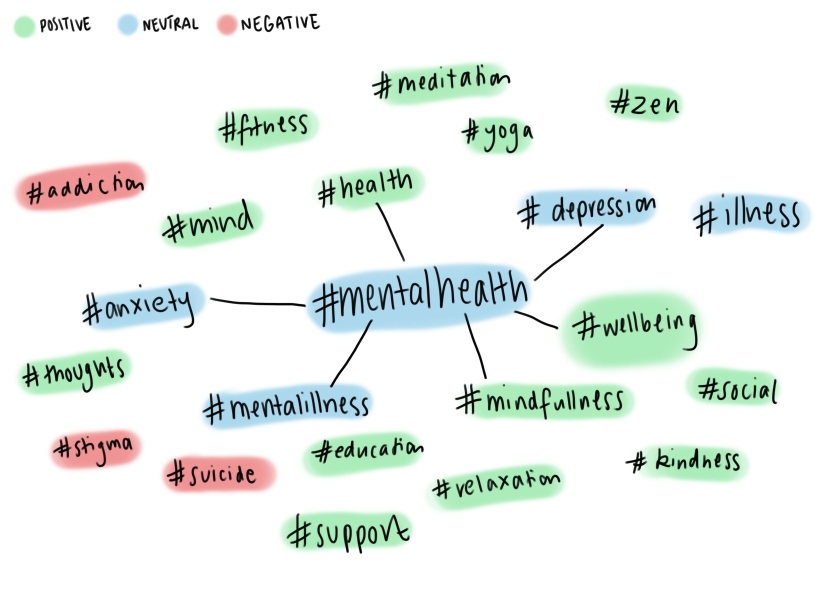LAUREN FITZPATRICK // 12048880
Social Media
Social media is a large and prevalent force within society. There are various social media platforms that people can use to obtain and share information on current issues in society. They are a simple way for people to interact and communicate their opinions and beliefs with each other on certain issues in the world. Social media is extremely powerful as it can be an agent for change and can heighten awareness on particular concerns in society.
For this research, I have used Twitter to gain further insight into the perspectives of mental health in Australia. Twitter enables registered users on various devices to send, read and share short messages limited to 140-characters. It is a free online social networking service that many people use to share their opinions on issues and receive information on particular topics. Tweets can be commented on, liked or retweeted and contain conversation threads, hashtags to connect to general topics, hyperlinks to relevant websites and tags to other users. Twitter is a public service so users can follow/ be followed by anyone and tweets are permanent and searchable.
Data Scraping Process
The process I used to collect data was the Twitter Archiver add-on in Google Spread Sheet. Once I had connected my Twitter account to my spread sheet, I created a rule to find tweets catered towards my issue. It took me a few attempts to achieve a good set of data. My more specific searches didn’t bring up any tweets so I first searched broadly using the hashtag #mentalhealth in Australia and in my second search I specified the words stigma, mental and health. This brought up lots of results from many different stakeholders. From here, I went back and forth between the spread sheet and exploring Twitter manually for tweets. Using the spread sheet and Twitter directly, I found this method of data collection quite beneficial and discovered more information about mental health.

Outcome of my data scraping
Below are some tweets that stood out to me in my data collection and analysis:





Reading through all these tweets from my data spread sheet made me realise that the view of mental health on Twitter is extremely positive. Having researched mental health continually for the past six weeks, it’s hard to see the positive side of the issue. Negativity and stigma are prevalent forces within the issues of mental health but I was pleasantly surprised to see the positivity and support displayed in these tweets. They mostly speak of increasing awareness of mental health issues, boosting positivity and helping spread the word for particular mental health illnesses and campaigns. This data demonstrates the power that social media has today in increasing awareness for particular issues.
Various stakeholders can also be identified through this data. Stakeholders on Twitter vary from people suffering and/or affected by mental health problems, bloggers about mental health and wellbeing, doctors and health professionals and also organisations such as SANE Australia. A lot of opinionated data can be collected from these individual profiles to gain a greater insight into the issues of mental health and how these stakeholders play a part within the issue.
Through my analysis of my data and further research, I have also identified some main hashtags used in relation to mental health which I have categorised into a mind-map (yes, another mind-map) below. Main hashtags that I discovered included:
- #mentalhealth
- #stopthestigma
- #stigma
- #depression
- #anxiety
- #wellbeing
- #mindfulness
Other hashtags that were quite prevalent in my searches include:
- #ImEndingStigmaBy
- #22pushupchallenge
- #imnotashamed.
- #EndTheStigma
- #SickNotWeak

Hashtags demonstrate what is trending and provides an overview of particular topic, in this case, mental health. Again, it is interesting and enlightening to see that most of the hashtags used are positive and forward thinking.
After wading through all that data, I have created a five point summary about my experience of data scrapping and my view of Twitter:
- Positivity stood out amongst the negativity.
- Hashtags are annoying, yet helpful for data purposes.
- Social media has a great power to boost awareness of issues.
- Opinionated data offers a greater insight into various issues.
- Use Twitter wisely; anyone can see it.
Visual Design Responses
It is still hard to say at this stage what design responses I could use to visualise this data as the information I have collected is still quite broad and abundant. A possible visual design response for this data on the issues within mental health could manifest as an interactive installation outlining the stakeholders involved and emotions experiences. I believe emotions and empathy is a key factor in understanding mental health issues. An engaging design like an installation would make the issue real to the audience. I would also like to explore the disconnect experienced when articulating ones mental state and how this can be perceived as attention seeking. Again, I could use emotions and feelings experienced by people to perhaps create a generative design response.





You must be logged in to post a comment.